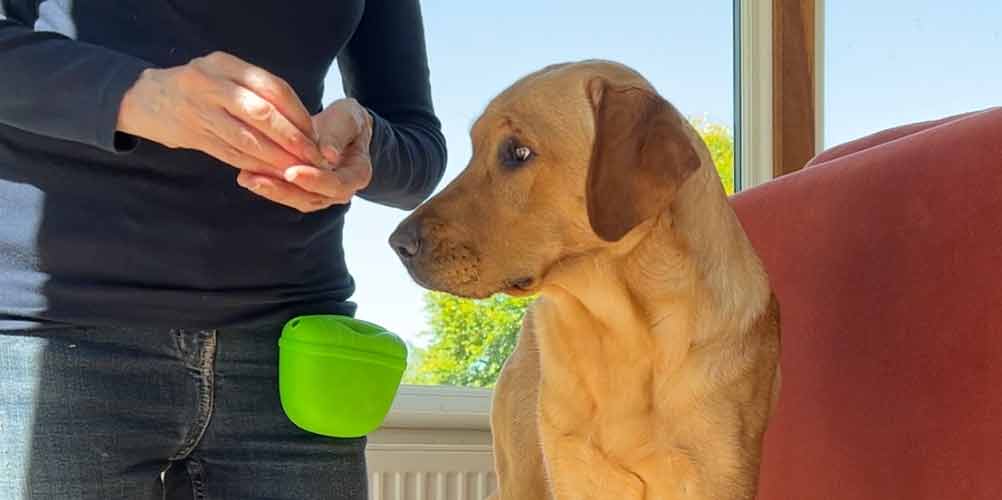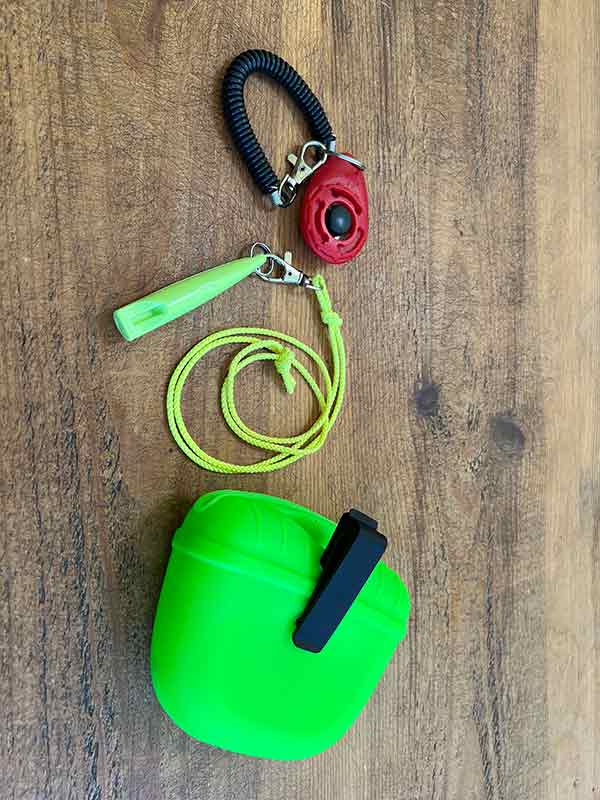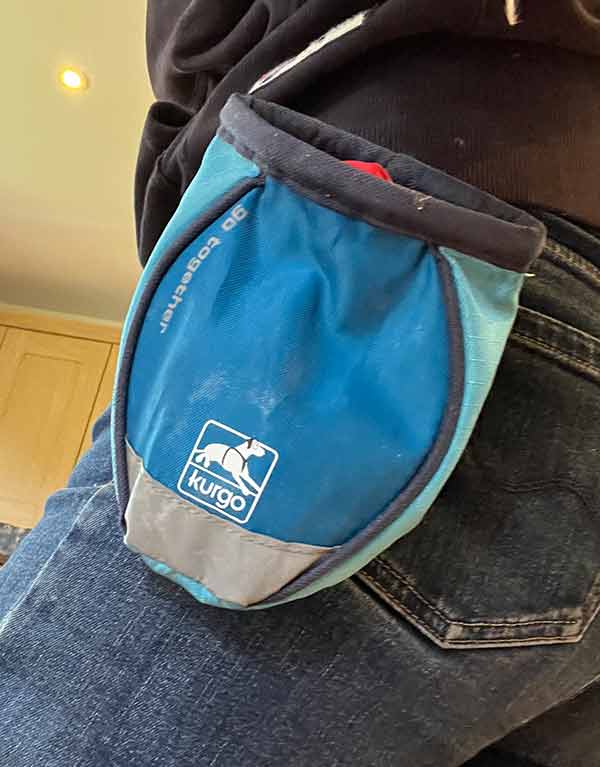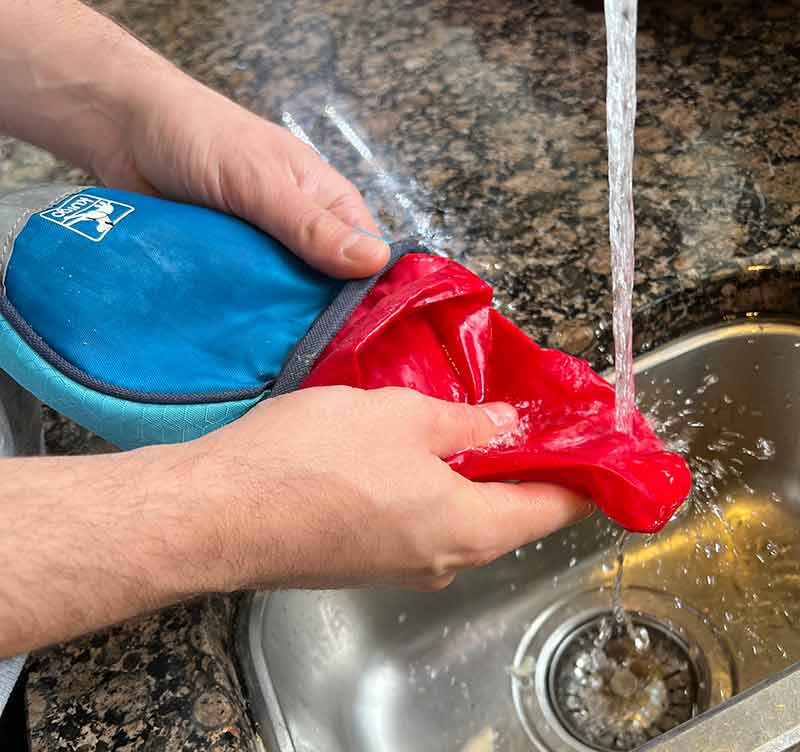
People often ask me which are the best dog training treat bags and I have tried quite a few!
This guide is about sharing what I have learned and maybe saving your pockets from a few crumbs.
If you decide to make a purchase from one of the links marked ‘paid’, Dogsnet may earn a small commission on that sale. This is at no extra cost to you.
Dog Treat Bags
When I first started training dogs with food, there was very little choice when it came to dog training treat bags.
Mostly I just filled my old jacket pockets with kibble, or tiny pieces of toast and cheese.
You can imagine what my jacket smelled like when I forgot to clean out my pockets at the end of a training session!
Now of course, positive dog training is now the method of choice for professionals and pet owners alike. And we all need somewhere to put those treats.
This means that the demand for dog treat pouches has increased. And there is now plenty to choose from in the way of commercially produced dog treat bags on the market.
Is There A Winning Treat Bag?
I actually don’t think there is a single best treat bag. But there are a couple that I prefer above all the others. I have two different types of bag, silicone, and fabric. And I’ll talk a bit about the pros and cons of these types below. The bag at bottom of the photo below is my silicone dog treat pouchPaid Link
 Paid Link
Paid LinkThe other items in the photo above are my Acme 210.5 dog whistlePaid Link and my favorite red clickerPaid Link! It used to be black or nothing, but the both come in a huge range of colors nowadays.
Which Type Of Treat Bag Do I Need?
Part of my choice is down to personal taste, but as your situation may be a little different from mine, there are a few important requirements you might want to consider before you make your own purchase
The first is that your treat bags must be easily washable.
It’s not much fun struggling to rinse bits of food out of the seams under a running faucet.
Ideally, you want to be able to drop the whole thing into a washing machine or into the dishwasher (I’ll get to which is best) and have it come out smelling as fresh as a daisy.
Washing Machine Vs Dishwasher
Some manufacturers of treat bags don’t state that their dog treat bags are machine washable, but over the years I have put many different brands of fabric type treat bag in the washing machine and not had a problem with bags being damaged.
If you don’t want to take a chance of your bag being damaged by the washing machine, then at least pick a bag with a liner that can be pulled out for easier access to cleaning the interior.
With the silicone type bags, I simply turn these inside out and put them in the top rack of the dishwasher with the opening facing downwards. This seems to work pretty well, though I suspect the plastic clips that attach them to your waist may get brittle with repeated exposure to high temperatures, as I’ve had a few of these clips snap over the years.
If you use fabric bags you need definitely need more than one. That’s because they take a while to dry and you need to be able to grab a treat bag whenever you have a spare moment to train. You don’t want to be waiting for your treat bag to drip dry.
 Paid Link
Paid LinkI guess you could try putting them in the tumble dryer but this is not something I have tested yet so I can’t recommend it. The silicone bags can be dried in an instant with a cloth or some paper towel, and this is one of the reasons I like them.
Treats Should Be Close By
Everyone who switches from traditional training to treat based training struggles at first with the notion that you need treats to be ready at hand in a variety of locations. Treat pots and a treat pouch or bag needs to be easily ‘to hand’ around your home.
Positive reinforcement has to be applied at the moment it happens. Not ten minutes later when you have dug out that Tupperware box you stored at the back of the fridge.
I suggest you always have a clean dry bag with some kibble in it, so that you can grab any opportunity to reward your dog even if you don’t have any high value treats to hand.
Winter Vs Summer
The type of bag you need may depend on what you are wearing. In the summer if I am just wearing a t-shirt and jeans, I use treat bags that clip on my belt or jeans pocket.
In the winter, I tend to use fabric treat bags that sit inside a jacket pocket as I don’t like wearing a belt over my jacket. You don’t want to be fumbling inside your jacket for treats if its cold.
I have tried lining a jacket pocket with a plastic bag, but this isn’t ideal mainly because the opening tends to collapse.
Easy Access Matters!
This is a key factor that you need to take into account when you purchase a dog treat bag. The bag needs to have an opening that stays open.
With fabric bags this is usually achieved by some kind of circular stiffener around the top of the bag. Climbers have used these, for chalk, for years and they allow you to get your hand into the bag and out again in a second.
You need this feature because reinforcement needs to be pretty much immediate to be effective.
It’s no good struggling to get your hand into a treat pouch that has collapsed into a heap in the bottom of your pocket, while your dog gets bored and wanders off to find a leaf to chase. And if your dog is kind enough to hang around it’s frustrating to see them patiently waiting for their reward and not be able to get at those treats.
Avoiding Spills
While you want your bag to stay open while you are training, you don’t want the food in your bag to spill all over the place. A bag that doesn’t spill and yet is easy to access may seem like a contradiction in terms, but there are a couple of ways around this.
Good fabric dog treat bags provide a means of closing/sealing the bag once you have finished training.
This can be achieved by a zip or a drawstring closure, that pulls an inner layer across the top of the bag.
I actually prefer the drawstring option to the zip. And most decent bags now have this option.
With silicone bags the trend is for a slit like opening that stays snapped together all the time unless you actually push your hand through the opening. This is surprisingly easy to do. And the opening snaps shut once you’ve removed your hand which does prevent the treats tipping out every time you bend over.
Messy Treats
There may be times when you need to use messy treats.
That’s because sometimes, especially when you introduce training around distractions, you are going to need more powerful rewards. And powerful rewards are often wet and sticky!
What Do We Need?
Okay, so we need a bag with a mouth that stays open, but that can be closed when you want to close it.
A bag that is washable, and also waterproof inside, and unless we go for silicone we need several of these treat bags, so they need to be affordable.
So if silicone has this extra feature, why don’t I only use silicone bags?
Silicone Treat Pouch Pros And Cons
The silicone bags have some great features. You can dive your hand in without fuss, grab the treats and pull your hand out again, and the magnetic strips snap the opening shut again.
They are so easy to wash and dry, for me this is their main benefit. But they are not the most comfortable to wear.
The pouch itself is quite big and the clip is in the center, so the bags do tend to wobble a little as you move around. And occasionally when being especially energetic I’ve had a bag fall off.
Some manufacturers now offer silicone pouches with waist belts attached. But I must confess I don’t like them. The belt means I can’t just throw the bag in the top rack of the dishwasher. If I rinse it under the faucet, the belt gets wet and then feels unpleasant to wear.
And (this is something they have in common with fabric bags that come with belts attached) I don’t much like the feel of the narrow belt around my waist. I’d rather have something I can clip to my own belt.
So for now, I use silicone bags in the summer, clipped into my jeans pocket and just accept that very occasionally, the bag might fall off.
Fabric Bags Pros And Cons
Because fabric bags are softer, they feel nicer against your body and don’t tend to wobble around. I use a small carabina to clip mine onto a belt loop or, in the winter I use a narrow bag that sits inside my jacket pocket.
I have tried a lot of different fabric bags and my favorite is the KurgoPaid Link When I bought mine they only came in red and bright blue. When writing this I notice that they now do a smart navy blue one, which I think will be my next purchase!
So many treat bags are over engineered. They contain a pocket for every eventuality, poop bags, keys, mobile phone. And these might be ok if you are looking for more of a general dog walking bag.
For me, I already have a secure jacket pocket for my phone and keys, and I like to keep my treat bag simple. The Kurgo does this and it’s shape means that in the winter, it slips easily into my jacket pocket.
The drawstring closure prevent spills when I am not training, and the inner lining can be pulled inside out for a quick rinse if you don’t need to wash the whole thing.
 Paid Link
Paid LinkOn the downside, these bags take a while to dry so I have three of them. But they are very reasonably priced.
I’m sure you can see what I mean about not every feature being relevant to every dog owner. You might prefer to have a bag with its own belt that you clip on over whatever you are wearing.
Either way, I do recommend you go for washable, with an easy access opening, and closure to prevent spills.
I should probably add that I am not sponsored in any way by the manufacturers of these two treat bags. I just happen to like them . Let me know in the comments below which type of bag you chose. I’ll be testing a few more out in the comings months so check back for updates!
Affiliate link disclosure: Links in this article marked with ‘paid link’ are affiliate links, and Dogsnet may receive a small commission if you purchase these products. I only recommend products that I have tested and used myself.

Free Training Tips
Get Pippa's free dog training tips delivered to your inbox

 First Steps In Dog Training For All Dogs Young Or Old
First Steps In Dog Training For All Dogs Young Or Old
I have several treat bags and the silicone ones are great for wet or sticky treats. However, with a labrador who will chew anything remotely connected with food, and especially his treat bags if they are left within a 5m reach zone, I always remove the very small magnets that help keep it closed because I don’t want the slightest risk of him ingesting a magnet
Good point! Thanks for sharing that thought ❤️
Thank you for this helpful summary of what one needs in a treat bag. You covered all the main points except one – where do you carry the poop after you have picked it up with the handy poop bags dispenses from the side pocket dispenser? No treat bag makes that I’ve encountered acknowledges that you need somewhere to put it after you pick it up. I consider this a grave oversight. I have a smallish dog with smallish poops so I make do with one of the ancillary pockets. Wouldn’t work so well for a largish dog with largish poops.